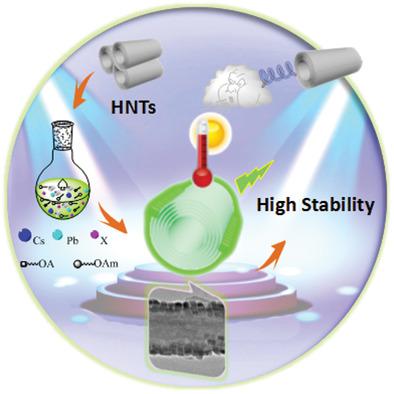当前位置:
X-MOL 学术
›
Adv. Opt. Mater.
›
论文详情
Our official English website, www.x-mol.net, welcomes your feedback! (Note: you will need to create a separate account there.)
One‐Step Loading on Natural Mineral Halloysite Nanotube: An Effective Way to Enhance the Stability of Perovskite CsPbX3 (X = Cl, Br, I) Quantum Dots
Advanced Optical Materials ( IF 9 ) Pub Date : 2018-12-11 , DOI: 10.1002/adom.201801323 Jiarui Hao 1 , Xingyu Qu 1 , Lei Qiu 1 , Guogang Li 1 , Yi Wei 1 , Gongcheng Xing 1 , Hongquan Wang 1 , Chunjie Yan 1 , Ho Seong Jang 2 , Ziyong Cheng 3 , Jun Lin 3, 4
Advanced Optical Materials ( IF 9 ) Pub Date : 2018-12-11 , DOI: 10.1002/adom.201801323 Jiarui Hao 1 , Xingyu Qu 1 , Lei Qiu 1 , Guogang Li 1 , Yi Wei 1 , Gongcheng Xing 1 , Hongquan Wang 1 , Chunjie Yan 1 , Ho Seong Jang 2 , Ziyong Cheng 3 , Jun Lin 3, 4
Affiliation

|
Currently, poor luminescence stability seriously impedes the practical application of inorganic halide perovskite (CsPbX3, X = Cl, Br, and I) quantum dots (QDs) in optoelectronic devices. In present work, CsPbX3 QDs are successfully assembled on natural mineral halloysite nanotubes (HNTs) for improving the luminescence performances. Monodispersed CsPbX3 QDs are arranged on two edges of HNTs in a highly ordered manner, which possibly originates from the electrostatic interaction between halogen ion and surface hydroxyl (SurOH2
+) on the section face of HNTs. As expected, the photoluminescence (PL) performances of CsPbX3@HNTs nanocomposites are obviously improved. The PL intensity still can be maintained even 80% when working at 100 °C. Almost no emission degradation is observed after storing in an open ambient condition for 28 days. Moreover, the PL intensity also maintains 82% of room temperature (RT) intensity after continuously being illuminated by 365 nm UV lamps for 144 h. Excellent white light with Commission Internationale de l'Eclairage (CIE) chromaticity coordinates (0.34, 0.32) of the white light‐emitting diodes (w‐LEDs) fabricated by CsPbBr3@HNTs, CsPbBr1.2Cl1.8@HNTs, and CsPbBr1.2I1.8@HNTs phosphors are achieved. This work opens up a new insight in achieving stable CsPbX3 QD‐based multifunctional materials by designing nanocomposites with natural clay mineral.
中文翻译:

一步一步加载天然矿物埃洛石纳米管:一种增强钙钛矿CsPbX3(X = Cl,Br,I)量子点稳定性的有效方法
当前,差的发光稳定性严重阻碍了无机卤化物钙钛矿(CsPbX 3,X = Cl,Br和I)量子点(QDs)在光电器件中的实际应用。在目前的工作中,CsPbX 3 QD成功地组装在天然矿物埃洛石纳米管(HNT)上,以改善发光性能。单分散CsPbX 3量子点设置在HNTS的两个边缘以高度有序的方式,这可能源自从卤离子和表面羟基之间的静电相互作用(苏尔 OH 2 +上HNTS的节面)。不出所料,CsPbX 3的光致发光(PL)性能@HNTs纳米复合材料明显得到改善。在100°C下工作时,PL强度仍可保持80%。在开放的环境条件下存放28天后,几乎没有观察到排放物降解。此外,在被365 nm紫外线灯连续照射144小时后,PL强度也保持了室温(RT)强度的82%。CsPbBr 3 @ HNT,CsPbBr 1.2 Cl 1.8 @HNT和CsPbBr 1.2 I制成的白色发光二极管(w-LED)的国际照明委员会(CIE)色度坐标(0.34,0.32)具有出色的白光实现了1.8 @ HNTs荧光粉。这项工作为实现稳定的CsPbX 3开辟了新的见解。 通过使用天然粘土矿物设计纳米复合材料,从而实现基于QD的多功能材料。
更新日期:2018-12-11
中文翻译:

一步一步加载天然矿物埃洛石纳米管:一种增强钙钛矿CsPbX3(X = Cl,Br,I)量子点稳定性的有效方法
当前,差的发光稳定性严重阻碍了无机卤化物钙钛矿(CsPbX 3,X = Cl,Br和I)量子点(QDs)在光电器件中的实际应用。在目前的工作中,CsPbX 3 QD成功地组装在天然矿物埃洛石纳米管(HNT)上,以改善发光性能。单分散CsPbX 3量子点设置在HNTS的两个边缘以高度有序的方式,这可能源自从卤离子和表面羟基之间的静电相互作用(苏尔 OH 2 +上HNTS的节面)。不出所料,CsPbX 3的光致发光(PL)性能@HNTs纳米复合材料明显得到改善。在100°C下工作时,PL强度仍可保持80%。在开放的环境条件下存放28天后,几乎没有观察到排放物降解。此外,在被365 nm紫外线灯连续照射144小时后,PL强度也保持了室温(RT)强度的82%。CsPbBr 3 @ HNT,CsPbBr 1.2 Cl 1.8 @HNT和CsPbBr 1.2 I制成的白色发光二极管(w-LED)的国际照明委员会(CIE)色度坐标(0.34,0.32)具有出色的白光实现了1.8 @ HNTs荧光粉。这项工作为实现稳定的CsPbX 3开辟了新的见解。 通过使用天然粘土矿物设计纳米复合材料,从而实现基于QD的多功能材料。



























 京公网安备 11010802027423号
京公网安备 11010802027423号